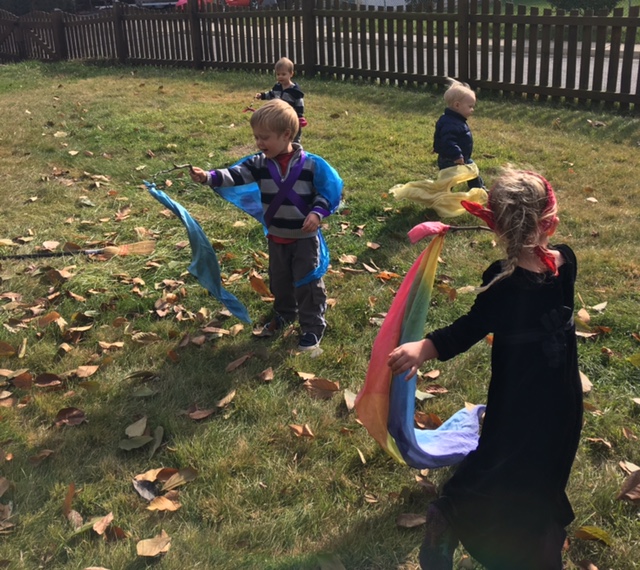 When we are creating a work space – an office, a classroom, a retail establishment – there are certain tools we need for specific tasks. We wouldn’t normally think of using a hammer to screw a socket into the wall or a screwdriver to drive a nail into a cabinet. We try to find the tool that best serves the need for the task at hand. If we consider toys to be tools of early childhood, we need to give some thought to what types of toys best serve the child through the various stages of development.
When we are creating a work space – an office, a classroom, a retail establishment – there are certain tools we need for specific tasks. We wouldn’t normally think of using a hammer to screw a socket into the wall or a screwdriver to drive a nail into a cabinet. We try to find the tool that best serves the need for the task at hand. If we consider toys to be tools of early childhood, we need to give some thought to what types of toys best serve the child through the various stages of development.
The most appropriate toys in the early years are simple and open-ended. The best toys are “90% child and 10% toy.” It is worth making the effort to find toys that will invoke the child’s natural creativity, imagination and healthy development. Toys made from natural materials, such as wood, rubber, wool, cotton, silk, and metal provide varied sensory experiences and are almost always non-toxic. Think of the “toy” that has most stood the test of time – the sandbox. It is hard to get more open-ended and natural than that! Watching young children at a public park, I am always struck by how fascinated they are with the stones and pebbles used in the walkways. The natural world readily provides numerous “playthings” for little ones.
Of course, another thing we consider when choosing toys is the age of the child. While birth through eight are considered the years of early childhood, we do not expect a six-month-old to be able to build a block tower. The following is an outline of the phases of early childhood and a consideration of the qualities most needed in toys.
Infant Toys
In infancy, the most available and most interesting “toys” are the child’s own extremities. Left to her own devices, a small baby will discover her fingers and toes and spend time talking to them and chewing on them. One might place one or two simple toys, like a wooden rattle, cotton handkerchief or small bowl, on either side of an infant so she can “discover” them as she reaches out. This encourages large motor development and often is the catalyst for learning how to roll over. This also helps to develop muscle coordination and strength. Self-initiated activity is better for the baby than contrived entertainment systems. Infants do not need infant gyms, mobiles, or other fancy gadgets as long as there are people around for them to observe. “….Short of being raised in isolation, a baby will encounter enough stimulation in most households to do the trick – anything from banging pots and pans together to speaking to a sibling. The key phrase here is ‘properly stimulated,’ which is not the same as expensively stimulated or the worse fate, over stimulated” (Rosenberg and Reibstein, Newsweek, Spring/Summer 1997).
Crawlers and Creepers to Early Toddlers
As infants become mobile, they are interested in everything in their surroundings. Anything has the potential to be a “toy.”This is the time when safety becomes an issue. Things that were able to be on a lower shelf now get moved up, for instance.
This is a good time to introduce toys that move – the rocking horse, the pushcart, soft knitted or wool balls, for example. Toddlers also love things that can stack or fit inside each other, or things that have lids. Of course, toddlers are quite interested in the activities of older children and will even begin to imitate some of their creative play activities like pretending to have a tea party. Outside, the sandbox becomes an important place, and water play is welcomed. They also can spend an amazing amount of time “playing” with a knothole in a tree or a fallen pinecone if they are not interrupted. They are like little scientists, really “studying” the form and detail of things. Too many objects can be distracting and can keep them from discovering a variety of ways to play with just a few things.
Toddlerhood to Three
In late toddlerhood to around three is the beginning of exploring what it is to play “with” other children. There is a tendency toward what is commonly called “side-by-side” play. Children are aware of being with another child, but they are still living mostly in their own space. It is not a time of easy sharing. Imagine how a scientist would feel if she were intently studying something under the microscope and someone just took it away all of a sudden. It is a bit shocking and, in the case of children, often leads to tears. This is a natural part of growing up, however, and the caregiver uses discretion in helping to determine what the best solution is for the given incident. It is not necessary to have an overabundance of each thing in order to avoid conflict. Rather, such times are valuable learning experiences that often lead to surprising solutions.
Toys at this time include “home environments” such as little kitchen sets, dishes, tables and chairs that can be moved around to create “houses,” large cloths and dress-up clothes, large wooden puzzles that have beautiful pictures underneath single pieces, a few shaped animals and some simple musical instruments such as clappers or pentatonic chimes. The child is learning “thingness” and naming the objects, so it is important to provide toys that are identifiable yet beautiful.
Pre-School
As the child moves into pre-school age, many of these same toys are still applicable and needed, but play starts to become a bit more cooperative. Children begin to create story themes to accompany their imaginative play, so they spend part of their time gathering props. Depending upon how media-influenced the child has been, their props can be very creative. The media-saturated child tends to think things have to be a certain way (as advertised on TV or in a movie).
Children who are still free in their imaginations can turn a piece of wood into a telephone or loaf of bread. At this time, it is helpful to provide a variety of natural objects mixed with a few formed objects. For example, one would still provide toy dishes, but the child may decide that a piece of coconut shell is also a bowl or cup or that pine cones are the food being served. In other words, their toys no longer need to be as “formed” or “real” as those of the toddler, who is so busy identifying “things” for what they really are.
Five- and Six-Year-Olds
Around five, the child begins to move more and more into creative imagination. Chidlren still spend time plotting their themes, but that in itself can be fulfilling, and they may never get around to gathering many props. However, they still need potential props, especially those that will strengthen their large muscle development. Now they may want to have heavy playstands or furniture to move around to create roofs and walls for their environments. Outside it is a good time for fort building and other large motor activities. At the same time, we want to foster healthy fine motor development, so things like sewing baskets, yarn work and real tools become more important. Projects that extend over periods of time are desirable. This is especially important in our current fast-paced culture. The greatest gift we can give our children is the gift of time to really penetrate their play.
At a time when toy manufacturers tell us our children need more and more, this is actually a time when they are happy to create with less if we let them and offer encouragement. Playing store with empty boxes and colorful beads, working on projects, spending lots of time in nature and having ample large muscle activity by climbing, hauling things in wagons and using riding toys provides a full life of play. It is also a time when children enjoy creating small environments like the dollhouse or towers for their cars or decorated shoeboxes for their toy animals, etc.
The Doll
The doll continues to play an intimate roll in people’s lives, from infancy to grown up. For grown ups it is usually in the vein of a collector’s item rather than as a play object. For the child it is wonderful if the doll can become more of a “beloved,” rather than a part of a “collection.” Materialism encroaches upon us soon enough without encouraging our young children to become consumers through collections. When this happens, the doll, or whatever comprises the collection, loses that special intimate quality that calls forth nurturing from the child.
The infant’s doll is best represented by a simple knot doll that the child can chew on. Such dolls can be made from cotton flannel with a tied off head and hands that have been stuffed with wool.
As the child grows older, natural fiber dolls that have limbs and hair can be dressed, wrapped in blankets and loved. While the children may have them in various states of dress or undress throughout the day, it sets a good example to wrap them in blankets and tuck them away at the end of the day so the child can see us modeling how one cares for them. The doll is the only toy that actually represents a person, and it is important for the children to learn a particular kind of respectfulness for their care.
By providing the right toys for children at different ages, parents can provide them with the tools they need for creative play, which is truly “the work of early childhood.”
 Cynthia Aldinger is the founder and executive director of LifeWays North America. Author of the book Life is the Curriculum and co-author of the book Home Away From Home: LifeWays Care of Children and Families, Cynthia has lectured and presented internationally and is pedagogical director for trainings and seminars across the United States. She served fourteen years on the board of the Waldorf Early Childhood Association of North America. A mother and grandmother, Cynthia’s passion is the preservation of the playful spirit of childhood and helping to create home-like environments that provide the comfort, security and activities found in a healthy home.
Cynthia Aldinger is the founder and executive director of LifeWays North America. Author of the book Life is the Curriculum and co-author of the book Home Away From Home: LifeWays Care of Children and Families, Cynthia has lectured and presented internationally and is pedagogical director for trainings and seminars across the United States. She served fourteen years on the board of the Waldorf Early Childhood Association of North America. A mother and grandmother, Cynthia’s passion is the preservation of the playful spirit of childhood and helping to create home-like environments that provide the comfort, security and activities found in a healthy home.
SaveSave